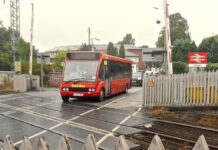The other week I was factchecking a letter on active travel and came across more information than I needed, but it was information that gave the plans encouraging people to walk and cycle some perspective.
As a local paper we and our readers tend to look at things on a microscopic scale: “They’re making the street outside my house one-way and it’s so annoying. I can only assume they are mad.” But wind it all back to a macroscopic scale and the picture is very different.
The unavoidable conclusion is that we are where we are because of bad planning.
In Congleton for example, it makes no sense at all to route hundreds of cars a day along a historic medieval street pattern that was never designed for cars, past such beautiful buildings as the Lion and Swan.
If the streets were currently for pedestrians only and someone suggested letting vans and cars thunder past all day, you’d tell them to give their head a wobble. It’s equally mad to force pedestrians to cross a busy dual carriageway that carves the town centre in two if they want to walk to the town’s gem of a park in their lunch hour.
Who in their right mind would plan a four-lane road on the main route to the town’s main leisure amenity?
And presumably the hideous blot that is Bridestones was designed to fit in with cars – heaven forbid someone had suggested making the town centre car-free and designed an attractive shopping centre that entrepreneurs would want to trade from, and shoppers would throng to. Far better to accommodate cars and create a stain on the town that’s never seen all its units rented out and boasts a draughty market square from which its traders can’t wait to escape.
Similarly in Holmes Chapel, all that traffic routed through a narrow village centre, with so little done that villagers are now threatening protests.
Reverting to the microscopic: working at home as I do, the “planners” – in quotes because it is in fact no planning at all – have left me in a position where if I want to take my kids to the park after I finish typing this, the car is the only option because it’s too dangerous to take them on their bicycles. It’s probably the same in Sandbach or Alsager. And I sold my car, so we can’t get to the park at all, at least not by any direct route. This makes no sense.
Nationally, all this poor planning has led to thousands of preventable deaths and injuries, particularly among vulnerable groups. It also leads to air pollution, and social and economic isolation, and encourages people not to make healthier choices such as cycling and walking.
The King’s Fund website lists some of the disadvantages of our temporary abandonment of good planning in favour of cars, and they’re sobering:
• Eight out of 10 people fail to achieve the recommended level of physical activity, and the poorer people are the more likely they are to fail, reinforcing other health inequalities;
• The cost to society of transport-induced poor air quality, ill health and road accidents is massive, exceeding £40bn a year – traffic accidents alone cost around £9bn annually;
• Greater vehicle use causes higher levels of air pollution, which may increase cardiovascular and respiratory conditions, and contributes to climate change;
• Traffic accidents cause around 250,000 casualties each year and kill almost 3,000 people, with those who live in the most deprived areas having a 50% greater risk of dying from a road accident than those in the least deprived areas (the latter presumably because they never have to cross busy roads to get anywhere).
Cycling to work reduces the relative risk of mortality by almost 40%, by reducing the risk of cardiovascular disease and obesity; cycling to work also results in lower absenteeism.
The King’s Fund reports that nearly 80% of car trips under five miles could be replaced by walking, cycling or using public transport.
Local authorities are supposed to promote active travel among their staff: I’ve no idea what Staffordshire Moorlands District Council or Cheshire East Council do, but Cheshire East has free parking outside its offices, which is not exactly going to deter staff from driving.
Moreover, the health and cost benefits of cycling far outweigh the risk of accidents – for every £1 spent on cycling provision, the NHS recoups £4 in reduced health costs, while the economy “makes” 35p profit for every mile travelled by bike instead of car. Whatever the cost of the controversial act travel schemes locally, they will save the NHS four times that.
Public health England reports that physical inactivity directly contributes to one in six deaths in the UK and costs £7.4bn a year to business and wider society, and that the growth in road transport has been “a major factor” in reducing levels of physical activity and increasing obesity.
Obviously, the best way to solve this is to build walking or cycling into people’s daily routines. Short car trips (under five miles) are the prime target for getting people to switch to active travel, or at least public transport.
They say “under five miles” but I would wager that in all the towns covered by the Chronicle, few places in any town are more than two miles away, probably no more than a mile.
And to be brutally honest, if you’re otherwise mobile and complain you can’t walk two miles (a mile there and back), you should be stressing more about your level of terminal unfitness than the fact that some “idiot” in the town hall wants you to walk that far.
The worst thing about all this is that the reports I found are mostly getting on for a decade old.
Ten years and very little done: it’s taken a pandemic, and the excuse of making towns covid safe, to give politicians the backbone to do anything.
Sign in
Welcome! Log into your account
Forgot your password? Get help
Password recovery
Recover your password
A password will be e-mailed to you.














